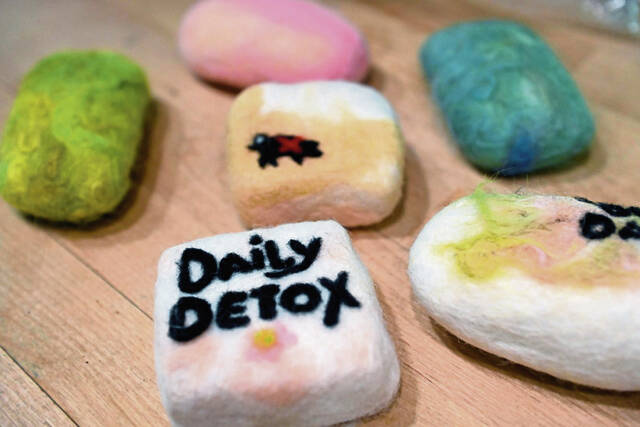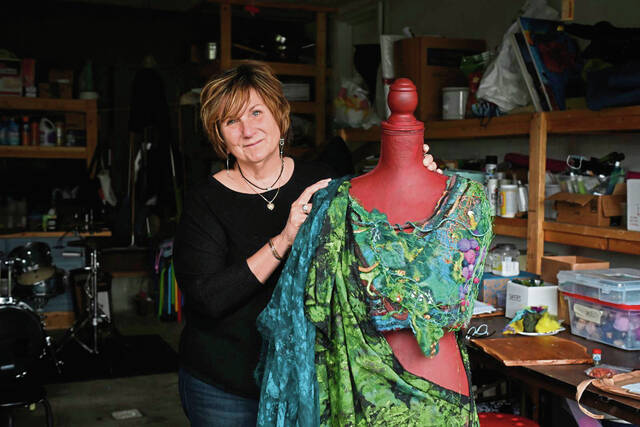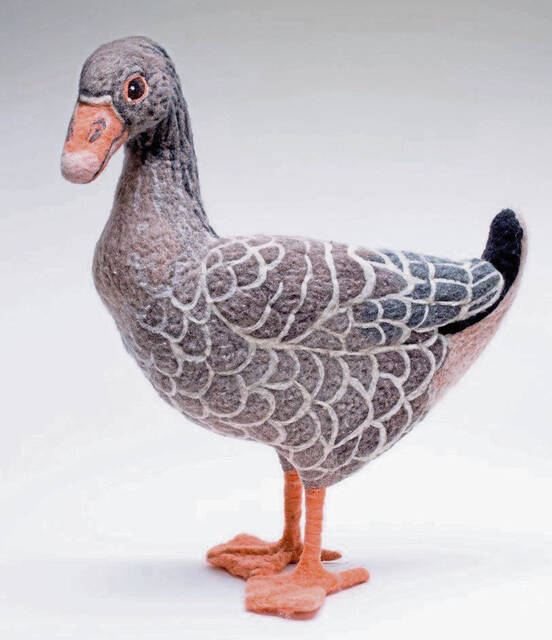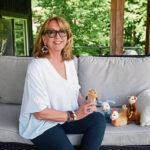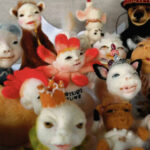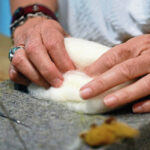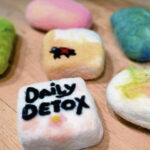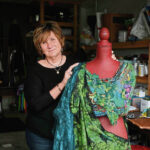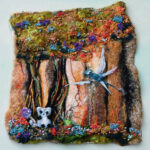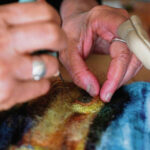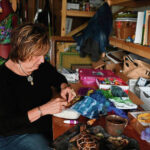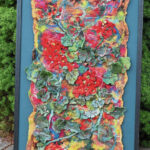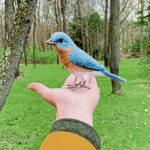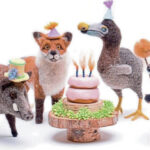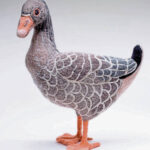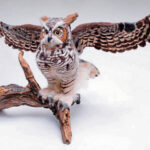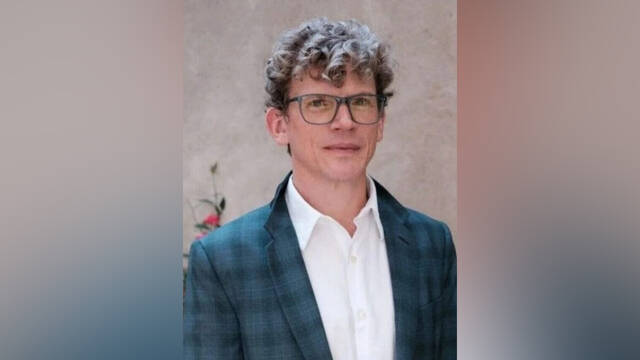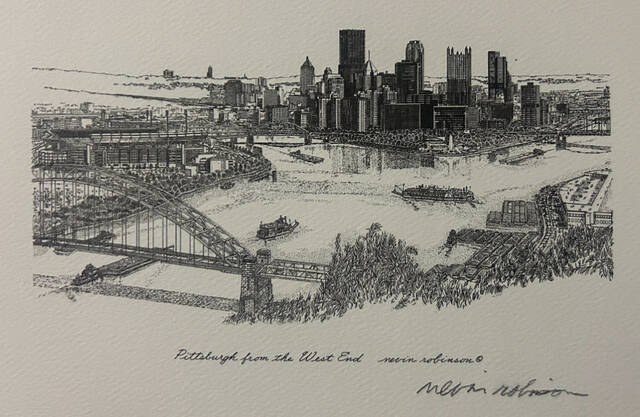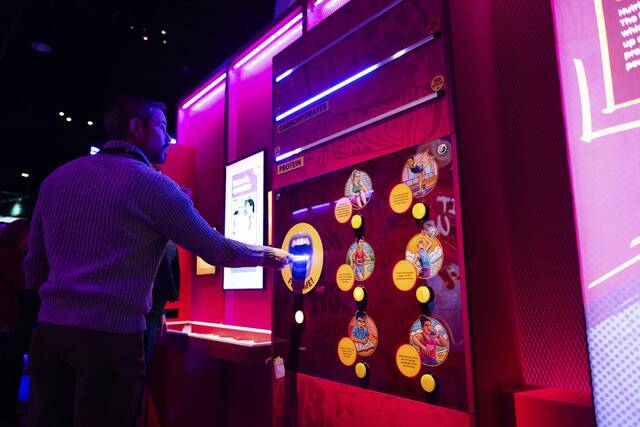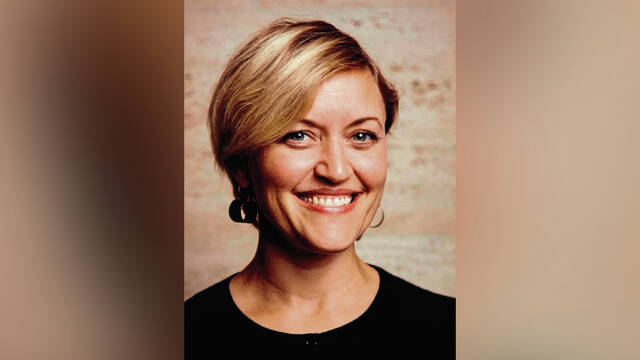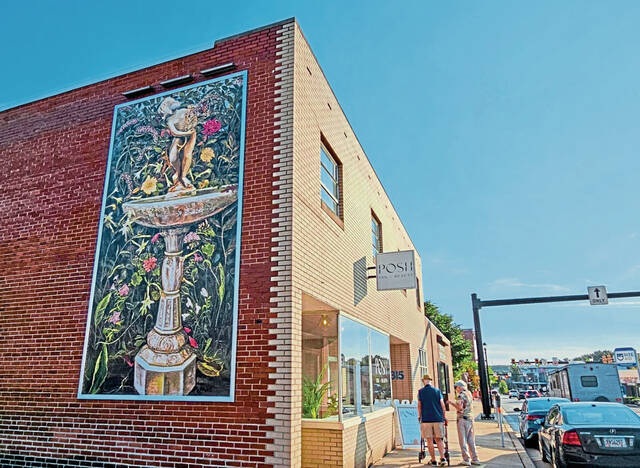A pastime that puts you at risk of poking yourself with a sharp needle doesn’t sound all that appealing — but its devotees risk the pricks to produce charming works of art.
They’re practicing needle felting, a craft that turns raw fibers into matted fabric that in turn can be transformed into just about any two- or three-dimensional creation imaginable, from an animal to a wall hanging to a piece of clothing.
Other felters eschew the needles and practice wet felting, in which wet fibers are agitated and compressed by hand until the matted fabric forms.
From there, the felter can manipulate it into different shapes and add different-colored fibers and other embellishments.
It’s a time-consuming process that takes attention to detail, said needle felter Carol Ludwig Kleber of Ligonier Township.
“It’s like sculpting, like clay,” said Kleber, whose specialty is felting miniature animals with human faces. “You start with your core wool and start rolling and poking. You start out, and it seems like you’re never going to have anything.”
But, with time and care, something beautiful can emerge.
“Felting, and fiber arts in general, seems to be having a moment — along with things like macrame, crochet and quilting,” said Mary Briggs, co-founder of You Are Here art space and gallery in Jeannette. “It’s part of a bigger trend of interest in what people used to call the homemaking arts.
“People are so connected electronically that I think they want to do something tactile.”
Love affair with fiber
Erin Carlson of Ohio Township said she “fell in love with fibers” while pursuing a writing degree with a fiber arts minor at Indiana University of Pennsylvania. At that time, her artistic output was focused on shibori, a Japanese tie-dyeing process, and pieced-quilt wall hangings.
After graduating in spring 2013, she picked up a book on felting while volunteering at the Carnegie Library in Oakland.
“I taught myself to felt that summer in my little apartment in Oakland,” she said. “It encompassed my interests in sculpting and wool and fiber. I like natural and organic forms, and it’s the perfect medium for sculpting animals.”
A member of the Craftsmen’s Guild of Pittsburgh, Carlson participates in the organization’s A Fair in the Park in Shadyside’s Mellon Park and in the Handmade Arcade.
She also sells her felted critters, cards with their likenesses and weavings online via her Red Cottage Fiber Studio.
“More than anything, I’m a birder, so birds are my go-to,” she said.
Kleber started needle felting around 2018 after receiving a kit for a felted monkey from her sister-in-law, who felted with her son during long winters in Alaska.
“They were posting pictures and I was like, ‘It’s so cool, how do you do it?’ ” she said. “I admired it, but I thought it looked super-hard.
“I followed the directions, made the monkey and it turned out well.
‘I realized that it’s not that hard.”
A graduate of the Art Institute of Pittsburgh with a degree in visual communications, Kleber worked across the country in advertising and marketing. She and her artist husband, John Kleber, also owned an art studio in San Francisco before retiring to their present home overlooking Loyalhanna Creek.
She started giving her felted animals to relatives and friends as gifts, which led to commissioned pieces. She now gets commissions by word of mouth and also sells on Etsy.
“When I started on Etsy, probably a good month went by and nothing happened. Then suddenly I sold one,” Kleber said. “It was a pig with a human face, and a vet in Delaware bought it. I was so excited. It was so validating.
“It’s not like I’m selling a lot, but just when I think, ‘Oh no, no one is buying them,’ I’ll sell one.
“I’ve been with Etsy for two years, and I’ve probably made 20 sales.”
Lightbulb moment
Mary Raneri of Unity has incorporated felting into a wide-ranging artistic practice. She is best known for her award-winning paintings and for the pandemic-era “Baking With Lucy” Facebook cooking sessions she did with her husband, Phil, and her late mother, Lucy Pollock.
She was introduced to felting around 2015 during a fiber arts class at Westmoreland County Community College.
“It was very basic stuff, but I started thinking, I could do colors, I could do 3-D stuff, and that was the lightbulb moment right there,” she said. “I started looking at all the things I could do.”
She does both needle and wet felting.
Recently, she has been felting various pieces with the title “Under Gram’s Grape Arbor,” including a wall hanging and wearable art with a felted top paired with a draped skirt made of fabric she batik dyed.
She also set herself the challenge of figuring out how to felt round haystacks on pieces reminiscent of Vincent van Gogh’s paintings of wheat fields.
“It’s taken me days to figure it out,” she said. “I told my friend, if I go to hell, I’ll be doing round haystacks there.”
Raneri’s felt works are for sale at Firebox Art Studios in Carnegie, which also carries some Nepalese felted finger puppets and stuffed animals distributed through a fair trade organization.
“Mary does some things that have an abstract painting quality that really are beautiful,” owner Eva Trout said. “She mixes techniques in her work, which is really interesting in terms of the process.
“There’s a lot of variety, a lot of color, a lot of texture, within her work. Obviously, it’s a textured medium, but she really utilizes a variety of textures within one piece.”
Risks and rewards
Versatility is part of the allure of felting, Raneri said, and people do seem to react positively to the work.
“Almost every time I’ve had it in a show, I’ve won something,” she said.
Having positive response to her work is rewarding, Kleber agreed, but, overall, felting is something she does mostly because she enjoys it, even though the process can be physically taxing.
“You can maybe felt for an hour and then you have to get up and move around, because it really gets to your shoulders and your neck. They’ll be on fire,” she said.
Aches and pains aside, felting is a practice with a meditative quality, Carlson said.
“It’s a very slow craft, much akin to knitting, so it’s a real time commitment — but I think maybe people are interested in slowing down and working with natural materials,” she said. “There’s a lot of repetition, and you can let your mind wander, as long as it doesn’t wander too far.”
That’s where the danger lies.
“When you crochet, you can watch TV, but this is not like that,” Raneri said. “You will poke yourself if you don’t pay attention.”
But it’s also a forgiving process.
“You can fix mistakes,” Carlson said. “If you decide your bird is looking more like an armadillo, you can just make it an armadillo.”





